Wind and Sea Breeze Characteristics for the Offshore Wind Farms in the Central Coastal Area of Taiwan
Abstract
:1. Introduction
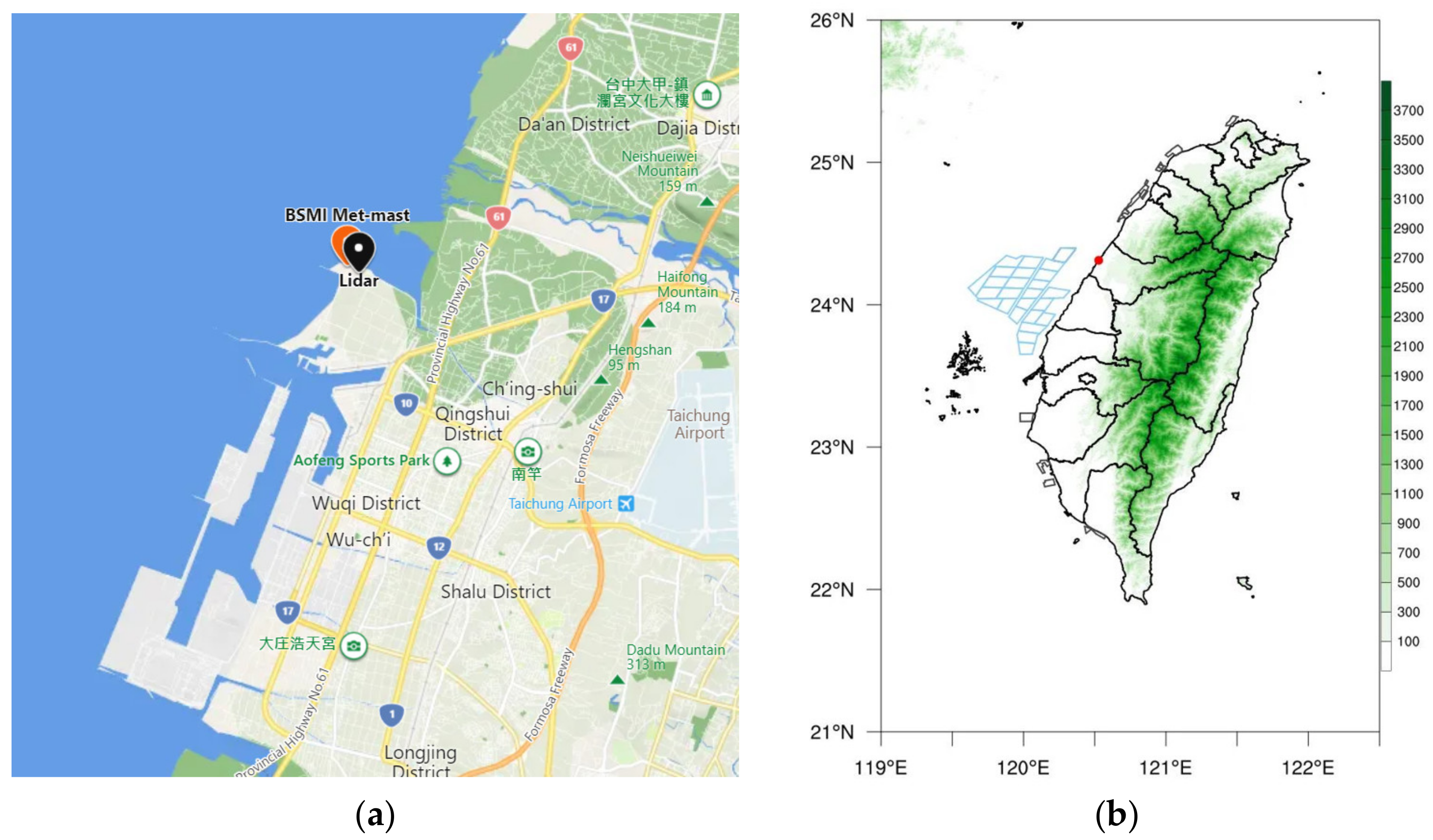
2. Data and Methods
2.1. Wind Speed Characteristics
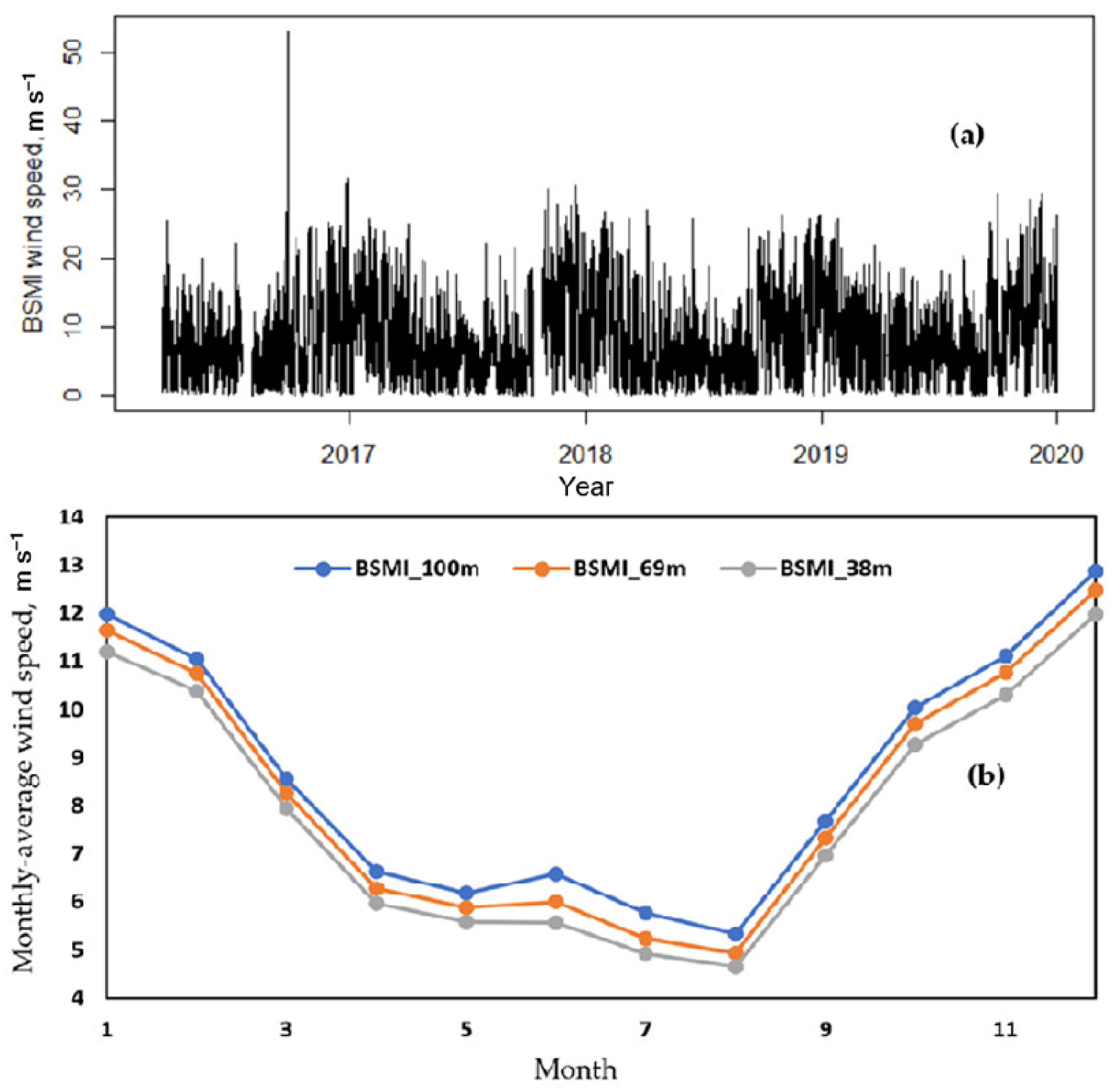
2.2. Types of Sea Breezes
2.2.1. The Ellipse and Average Vector Composite Hodograph (Abbreviated as EACH) Method: A New Identification Method for Sea Breeze Types
2.2.1.1. Specific Steps of This Method Are as Follows (Figure 5)
- Developing a hodograph with hiding vectors and no connections among the arrowheads of vectors for the purpose of clearness;
- Marking the arrowheads (e.g., blue circles);
- Adding the average velocity vector (denoted by A in Figure 5). Its magnitude and direction are represented by Av and Aθ, respectively;
- Fitting all velocities with an ellipse to obtain the length and angle of the semi-major axis (denoted by E in Figure 5). Magnitude and direction of E are represented by Ev and Eθ, respectively.
2.2.1.2. Main Ideas of the Plotting Method Are as Follows
- In the velocity diagram, the PW vector is replaced by an average wind vector (A);
- Wind speeds in a day at the same altitude are fitted by an ellipse;
- Identification of the sea breeze type depends on the angle among the average wind vector and the coastline;
- Weather conditions of candidates are used to verify whether the identification of the sea breeze type is correct (rules introduced in the next section);
- Thresholds of environmental variables (such as the temperature difference) of each sea breeze type can be set up;
- Conditions for candidates of maximum and minimum values on a certain time scale (such as the month and season) are analyzed, and these conditions might predict the sea breeze type and velocity.
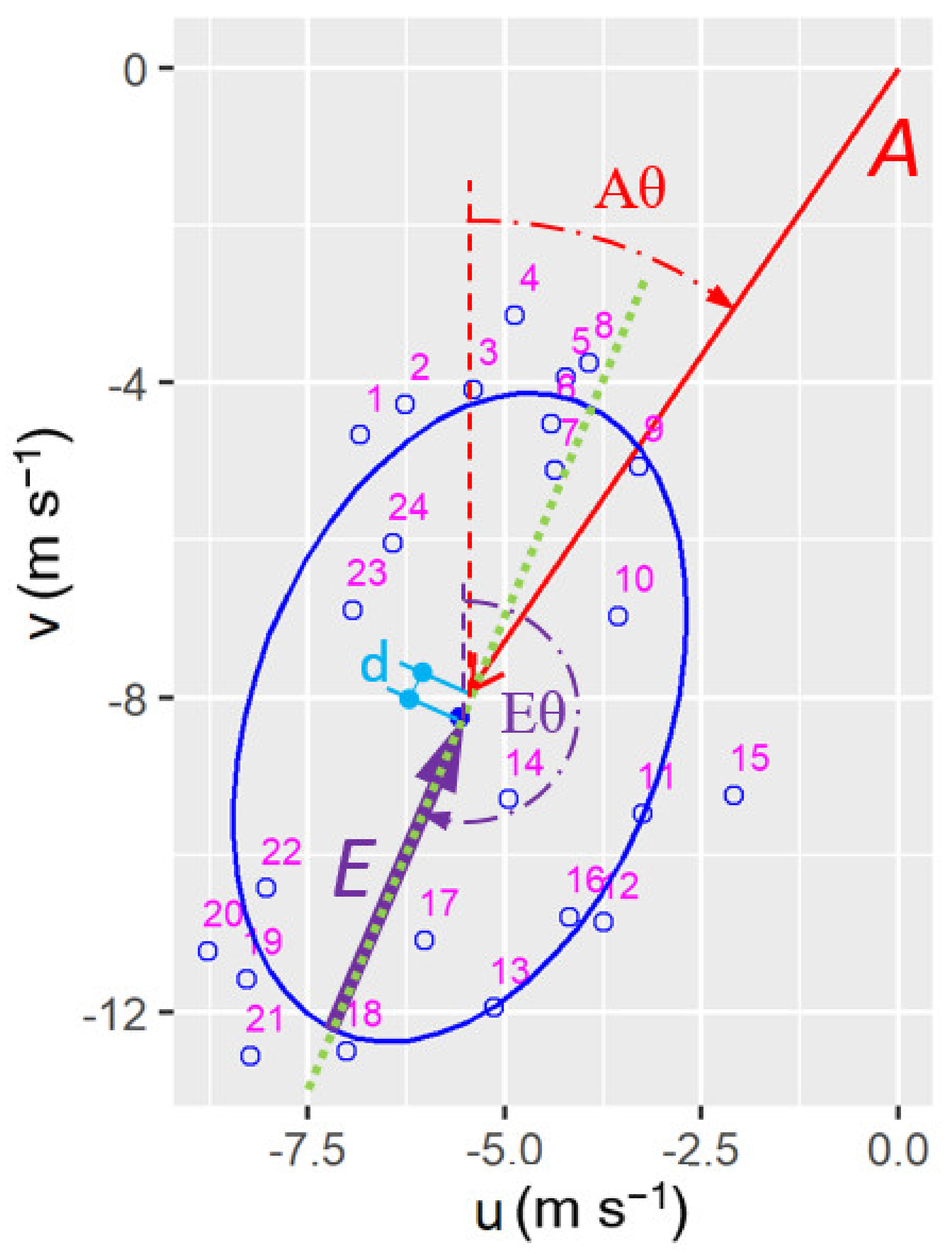
3. Results
3.1. Time Series Modeling of the Wind Speed

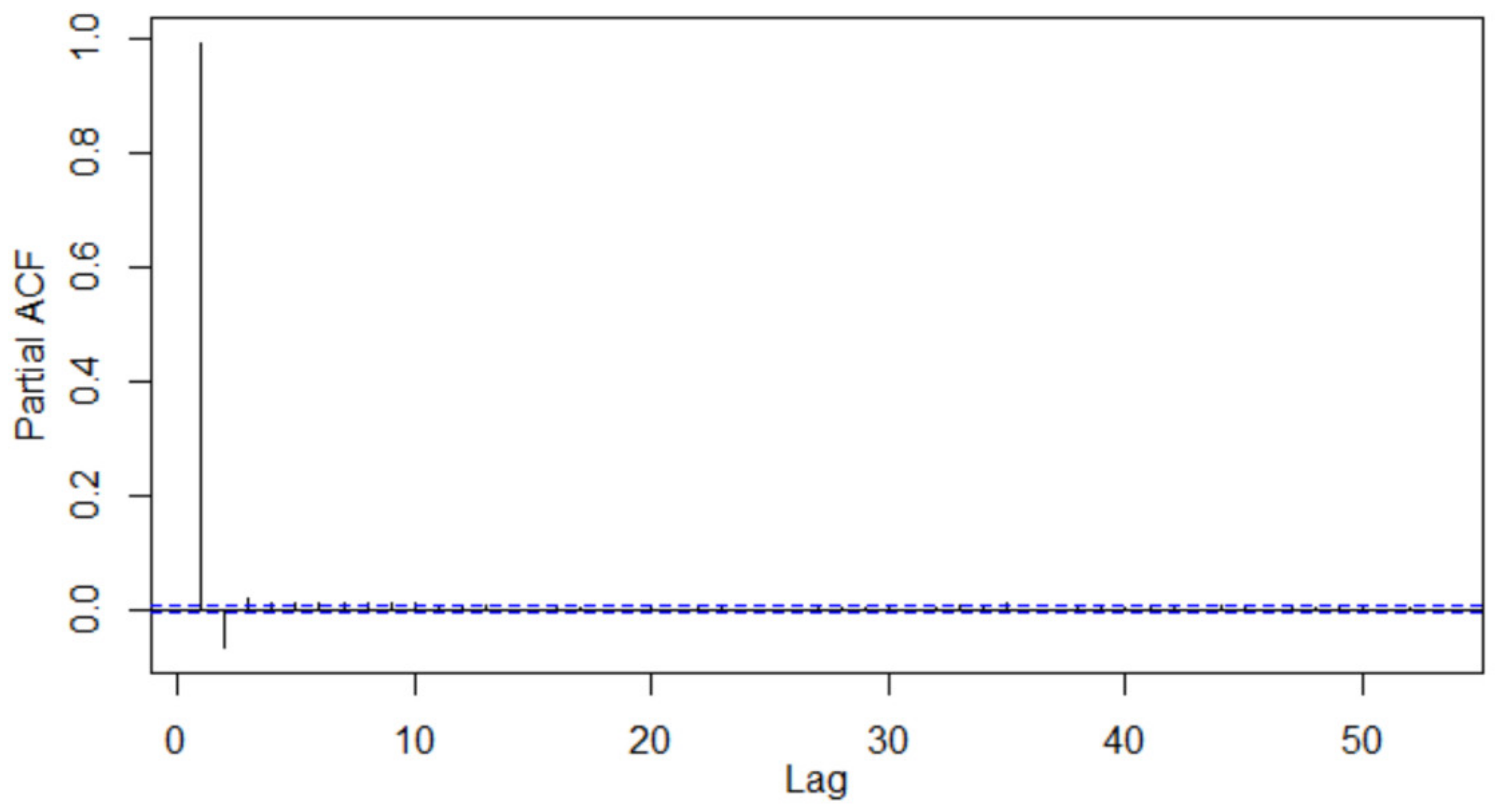
3.2. Case Study for the Application of the EACH Method
3.2.1. Rules
- 1.
- The angle between A and the coastal line determines the type of sea breeze due to the presence of the along-shore component, as mentioned in Section 2.2;
- 1a.
- Pure sea breeze occurs in weak synoptic PGFs. A approached the coastal line at a right angle (at some 300°, Figure 11);
- 1b.
- Corkscrew sea breeze occurs when A comes from the north ranging from 120° to 300° (counterclockwise in Figure 11). The presence of an along-shore component with land on the left caused a divergent area, resulting in the easy sinkage of high-altitude air. Usually, the daily peak of wind speed occurs in the late afternoon;
- 1c.
- Backdoor sea breeze occurs when an along-shore component comes from the south and A ranges from 120° to 300° (clockwise in Figure 11). The development of a convergent area inhibited the sinkage of high-altitude air. Usually, the daily peak of wind speed occurs around noon.

- 2.
- In corkscrew sea breeze, when the included angle between A and the coastline (approximately 60° with respect to the zonal direction) was greater than 30° (i.e., beyond [0, 60] in Figure 11), the extent of divergence and the speed of wind were decreased due to the decreased projection of wind speed onto the coastline. For example, included angles, from 10/3 to 10/5, between A and the coastline were greater than 30° (Figure 12);
- 3.
- 4.
- The minimum included angle between A and E, ignoring the orientation of vectors due to the symmetry of ellipses, was within ±20°. Under this situation, either the summation or subtraction of Av and Ev can be the candidate changing the trend of speed. Based on the surface weather chart of the studied cases, the situation was probably caused by a nearby weather system, such as fronts, depressions, and high pressures, resulting in a larger variation (more than 180°) in wind direction. During the average process of vectors, a large direction variation was likely to offset each other, resulting in unusual but similar angles;
- 5.
- 6.
- If the semi-minor axis of the ellipse was less than 1 m/s and the minimum included angle between A and E, ignoring the orientation of vectors due to the symmetry of ellipses, was within ±10°, sea breeze may be suppressed. For example, 4/15 (as shown in Figure 13).
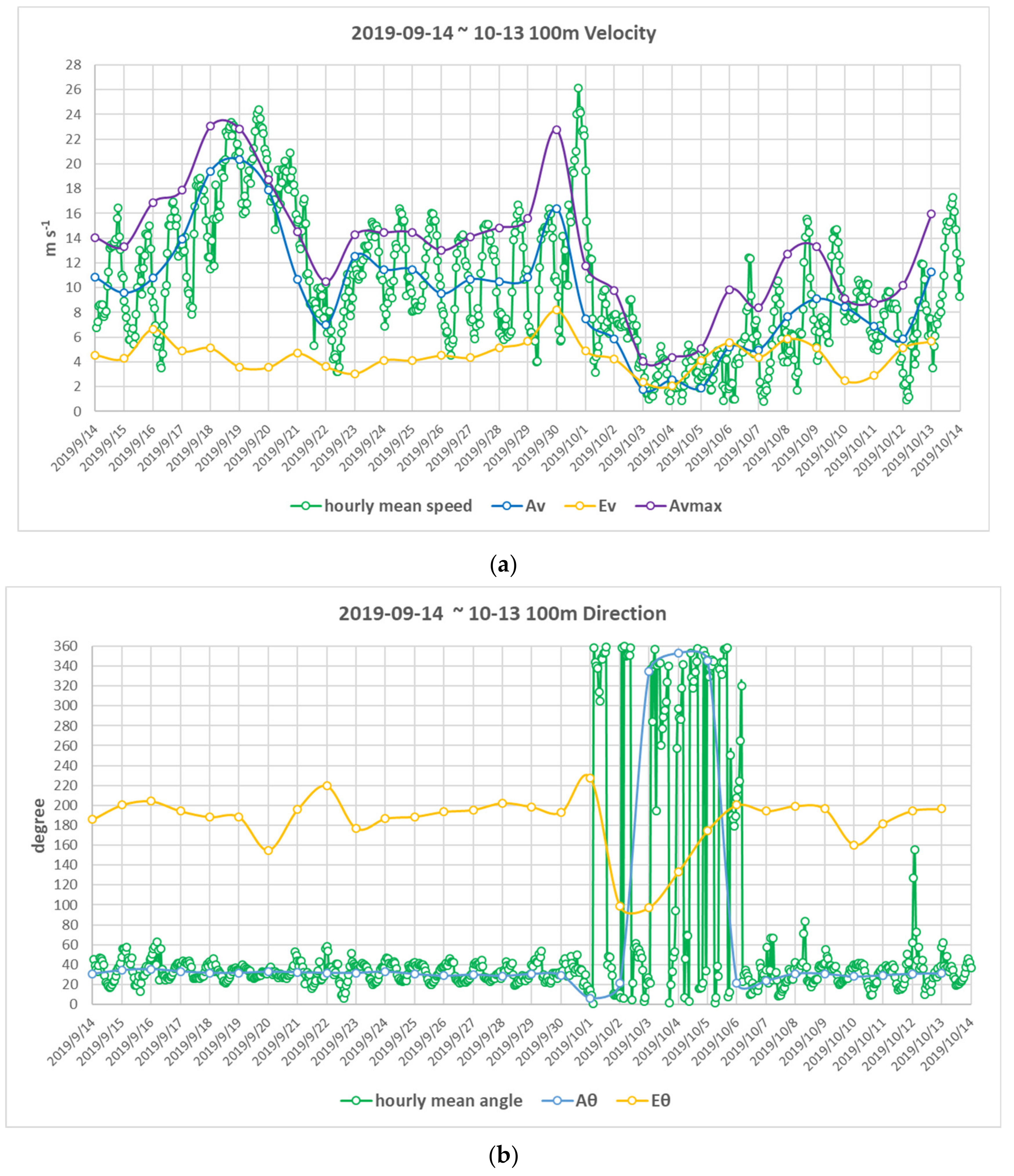
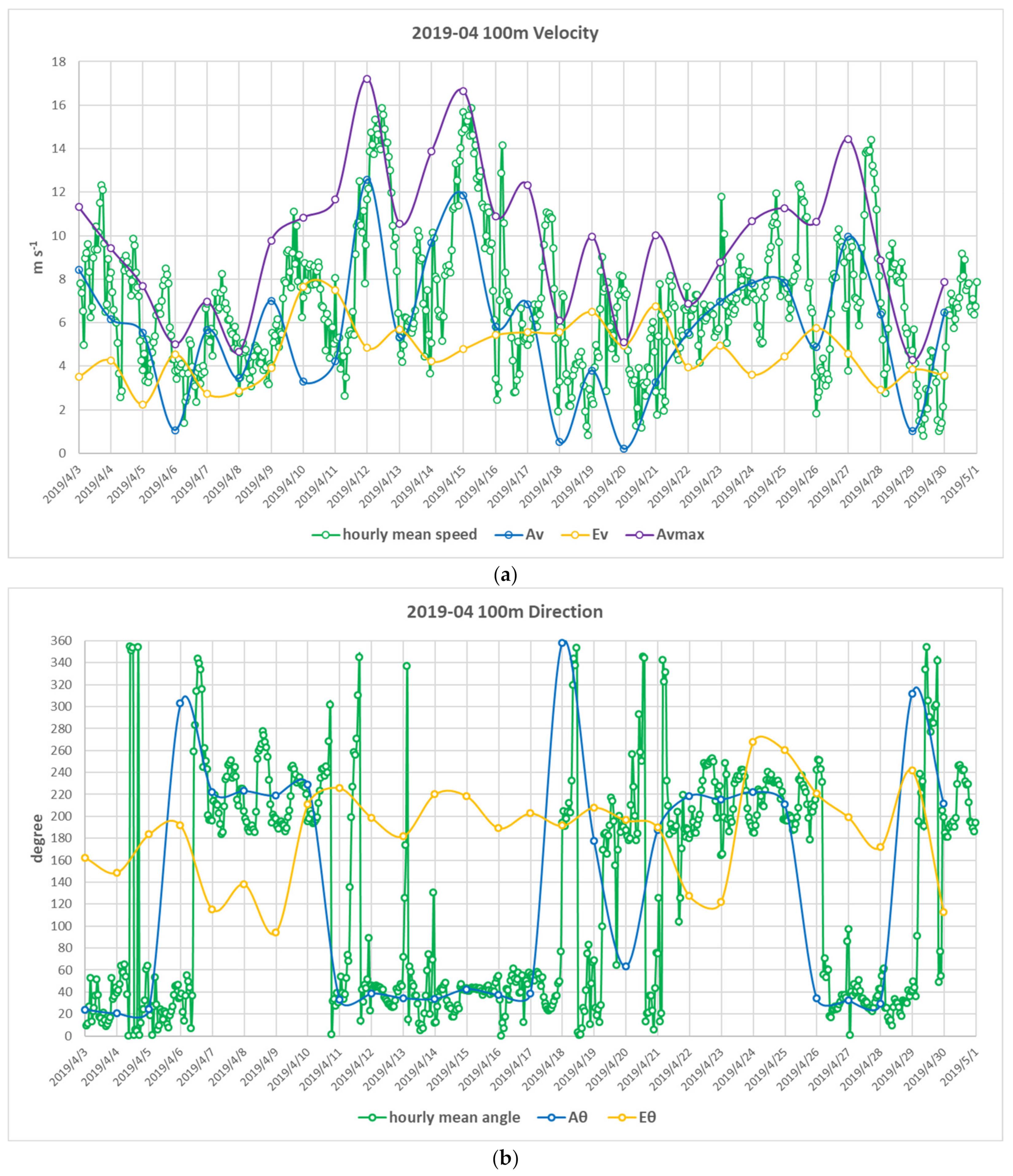
3.2.2. Verification
- Pure sea breeze on 6 April 2019
- Corkscrew sea breeze on 26 September 2019
- Backdoor sea breeze on 22 April 2019
- A special event on 15 April 2019 for rule 6.
4. Discussion
4.1. The EACH Method
- Applying rule 1 to classify the sea breeze types on the dates of interest;
- Applying rules 2 to 6 to find the vertices of speed curves as the candidates of extreme points;
- ◦
- Filtering out dates that comply with rules 6;
- ◦
- Keeping dates that comply with rules 2, 3, 4, and 5;
- Analyzing the weather conditions of candidates with the same sea breeze type to verify the sea breeze types. At the same time, determining effective environmental variables and their thresholds. Analyzing these thresholds to determine factors that results in candidates to have extreme values at a specific time scale, which could be predictors of sea breeze velocity. Because only filtered data are processed, the EACH method can speed up the analysis.
4.2. Daily Power Production of Each Sea Breeze Type
4.3. A Good Approximation of the Magnitude of Sea Breeze Speed
5. Conclusions
- The time series modeling, which takes into account the frequency domain and time domain characteristics, identified two periodic (annual and diurnal) components and a third-order autoregressive model for the multiple-year wind speed time series. An example was demonstrated that the proposed time series model yields good short period forecast results. The approach is general and can be applied to data series of other meteorological variables;
- There are distinct seasonal wind speed characteristics. Monthly-average wind speeds are high (>10 m s−1) in mid-autumn to winter (October to February) and low (<7 m s−1) in mid-spring to summer (April to August), with March and September being the transition period. Such seasonal characteristics explain the annual periodic component identified by the spectral analysis;
- The diurnal variation pattern also varies with months. The hours of peak occurrence of the high wind-speed months (October to February) are about 2 to 3 h later than that of the low wind-speed months (April to August), which is coincident with the situations caused by divergent zone and convergent zone related to sea breeze types. The time lag in the hours of peak occurrence of the high and low wind-speed seasons confirms that the sea breeze plays an important role in the magnitude of the wind speed;
- A new EACH method for sea breeze type identification is proposed in this study. The method converts the daily wind speed diagram into a constant average velocity vector which represents the effect of synoptic-scale weather system, and an ellipse which represents the effect of volatile regional weather system. The proposed method was further verified using the surface weather chart and lidar observation data;
- The proposed EACH method has the advantages of being scalable, adaptive, and easily programmable for an automated sea breeze type identification. It is also computationally efficient since only a few filtered days of wind speed data need to be processed;
- The verification process can collect environmental variables such as temperature difference, wind speed, wind direction, air humidity, air pressure, cloud cover, sunshine time, and precipitation for:
- ◦
- Setting up the thresholds of environmental variables to perfect rules;
- ◦
- Finding reasons for dates with trend-changing velocity to foresee variations in sea breeze speed.
- A good approximation for the magnitude of sea breeze velocity makes comparisons of different sites and different times easy;
- A hybrid model consisting of the third-order autoregressive model and numerical weather prediction model can be developed to predict the occurrence of extreme events more accurately;
- To analyze more offshore wind speed data of central Taiwan to further validate the EACH method and obtain more insights into offshore behaviors of sea breezes in order to harness offshore wind energy.
Author Contributions
Funding
Institutional Review Board Statement
Informed Consent Statement
Acknowledgments
Conflicts of Interest
References
- Offshore Wind-Power Generation. 13 June 2019. Available online: https://english.ey.gov.tw/News3/9E5540D592A5FECD/34ff3d6b-412e-458d-afe9-01737d2da52d (accessed on 1 November 2020).
- MOEA Plans a New Target to Develop Further 10 GW of Offshore Wind Capacity between 2026 to 2035-Anticipation of a Price Drop below the Average Consumer Price. 6 January 2020. Available online: https://www.moeaboe.gov.tw/ECW/english/news/News.aspx?kind=6&menu_id=958&news_id=16566 (accessed on 1 November 2020).
- Cheng, K.-S.; Ho, C.-Y.; Teng, J.-H. Wind Characteristics in the Taiwan Strait: A Case Study of the First Offshore Wind Farm in Taiwan. Energies 2020, 13, 6492. [Google Scholar] [CrossRef]
- Soman, S.S.; Zareipour, H.; Malik, O.; Mandal, P. A review of wind power and wind speed forecasting methods with different time horizons. In Proceedings of the North American Power Symposium 2010, Arlington, TX, USA, 26–28 September 2010. [Google Scholar]
- Milligan, M.; Schwartz, M.; Wan, Y.-h. Statistical Wind Power Forecasting Models: Results for US Wind Farms; National Renewable Energy Lab (NREL): Golden, CO, USA, 2003.
- Torres, J.L.; García, A.; De Blas, M.; De Francisco, A. Forecast of hourly average wind speed with ARMA models in Navarre (Spain). Sol. Energy 2005, 79, 65–77. [Google Scholar] [CrossRef]
- Gao, S.; He, Y.; Chen, H. Wind speed forecast for wind farms based on ARMA-ARCH model. In Proceedings of the 2009 International Conference on Sustainable Power Generation and Supply, Nanjing, China, 6–7 April 2009. [Google Scholar]
- Kavasseri, R.G.; Seetharaman, K. Day-ahead wind speed forecasting using f-ARIMA models. Renew. Energy 2009, 34, 1388–1393. [Google Scholar] [CrossRef]
- Rajagopalan, S.; Santoso, S. Wind power forecasting and error analysis using the autoregressive moving average modeling. In Proceedings of the 2009 IEEE Power & Energy Society General Meeting, Calgary, AB, Canada, 26–30 July 2009. [Google Scholar]
- Simpson, J.E. Sea Breeze and Local Winds; Cambridge University Press: Cambridge, MA, USA, 1994. [Google Scholar]
- Miller, S.T.K.; Keim, B.D.; Talbot, R.W.; Mao, H. Sea breeze: Structure, forecasting, and impacts. Rev. Geophys. 2003, 41, 124. [Google Scholar] [CrossRef] [Green Version]
- Steele, C.J.; Dorling, S.R.; von Glasow, R.; Bacon, J. Idealized WRF model sensitivity simulations of sea breeze types and their effects on offshore windfields. Atmos. Chem. Phys. 2013, 13, 443–461. [Google Scholar] [CrossRef] [Green Version]
- Steele, C.J.; Dorling, S.R.; von Glasow, R.; Bacon, J. Modelling sea-breeze climatologies and interactions on coasts in the southern North Sea: Implications for offshore wind energy. Q. J. R. Meteorol. Soc. 2015, 141, 1821–1835. [Google Scholar] [CrossRef] [Green Version]
- Borge, R.; Alexandrov, V.; Del Vas, J.J.; Lumbreras, J.; Rodríguez, E. A comprehensive sensitivity analysis of the WRF model for air quality applications over the Iberian Peninsula. Atmos. Environ. 2008, 42, 8560–8574. [Google Scholar] [CrossRef]
- Lee, S.-H.; Kim, S.-W.; Angevine, W.M.; Bianco, L.; McKeen, S.A.; Senff, C.J.; Trainer, M.; Tucker, S.C.; Zamora, R.J. Evaluation of urban surface parameterizations in the WRF model using measurements during the Texas Air Quality Study 2006 field campaign. Atmos. Chem. Phys. 2011, 11, 2127–2143. [Google Scholar] [CrossRef] [Green Version]
- Golding, B.; Clark, P.; May, B. The Boscastle flood: Meteorological analysis of the conditions leading to flooding on 16 August 2004. Weather 2005, 60, 230–235. [Google Scholar] [CrossRef]
- Crosman, E.T.; Horel, J.D. Sea and lake breezes: A review of numerical studies. Bound.-Layer Meteorol. 2010, 137, 1–29. [Google Scholar] [CrossRef] [Green Version]
- Liu, K.-Y.; Wang, Z.; Hsiao, L.-F. A modeling of the sea breeze and its impacts on ozone distribution in northern Taiwan. Environ. Model. Softw. 2002, 17, 21–27. [Google Scholar] [CrossRef]
- Lin, C.Y.; Chen, F.; Huang, J.C.; Chen, W.C.; Liou, Y.A.; Chen, W.N.; Liu, S.C. Urban heat island effect and its impact on boundary layer development and land–sea circulation over northern Taiwan. Atmos. Environ. 2008, 42, 5635–5649. [Google Scholar] [CrossRef]
- Yu, R.; Li, J.; Chen, H. Diurnal variation of surface wind over central eastern China. Clim. Dyn. 2009, 33, 1089–1097. [Google Scholar] [CrossRef]
- Shu, Z.R.; Li, Q.S.; Chan, P.W.; He, Y.C. Seasonal and diurnal variation of marine wind characteristics based on lidar measurements. Meteorol. Appl. 2020, 27, e1918. [Google Scholar] [CrossRef]
- Cook, N.J. A statistical model of the seasonal-diurnal wind climate at Adelaide. Aust. Meteorol. Oceanogr. J. 2015, 65, 206–232. [Google Scholar] [CrossRef]
- Yan, P.; Zuo, D.; Yang, P.; Li, S. Typical Modes of the Wind Speed Diurnal Variation in Beijing Based on the Clustering Method. Front. Phys. 2021, 9, 284. [Google Scholar] [CrossRef]
- Brown, B.G.; Katz, R.W.; Murphy, A.H. Time series models to simulate and forecast wind speed and wind power. J. Appl. Meteorol. Climatol. 1984, 23, 1184–1195. [Google Scholar] [CrossRef]
- Do, D.-P.N.; Lee, Y.; Choi, J. Hourly average wind speed simulation and forecast based on ARMA model in Jeju Island, Korea. J. Electr. Eng. Technol. 2016, 11, 1548–1555. [Google Scholar] [CrossRef] [Green Version]
- Huang, Z.; Chalabi, Z. Use of time-series analysis to model and forecast wind speed. J. Wind Eng. Ind. Aerodyn. 1995, 56, 311–322. [Google Scholar] [CrossRef]
- Haurwitz, B. Comments on the sea-breeze circulation. J. Atmos. Sci. 1947, 4, 1–8. [Google Scholar] [CrossRef] [Green Version]

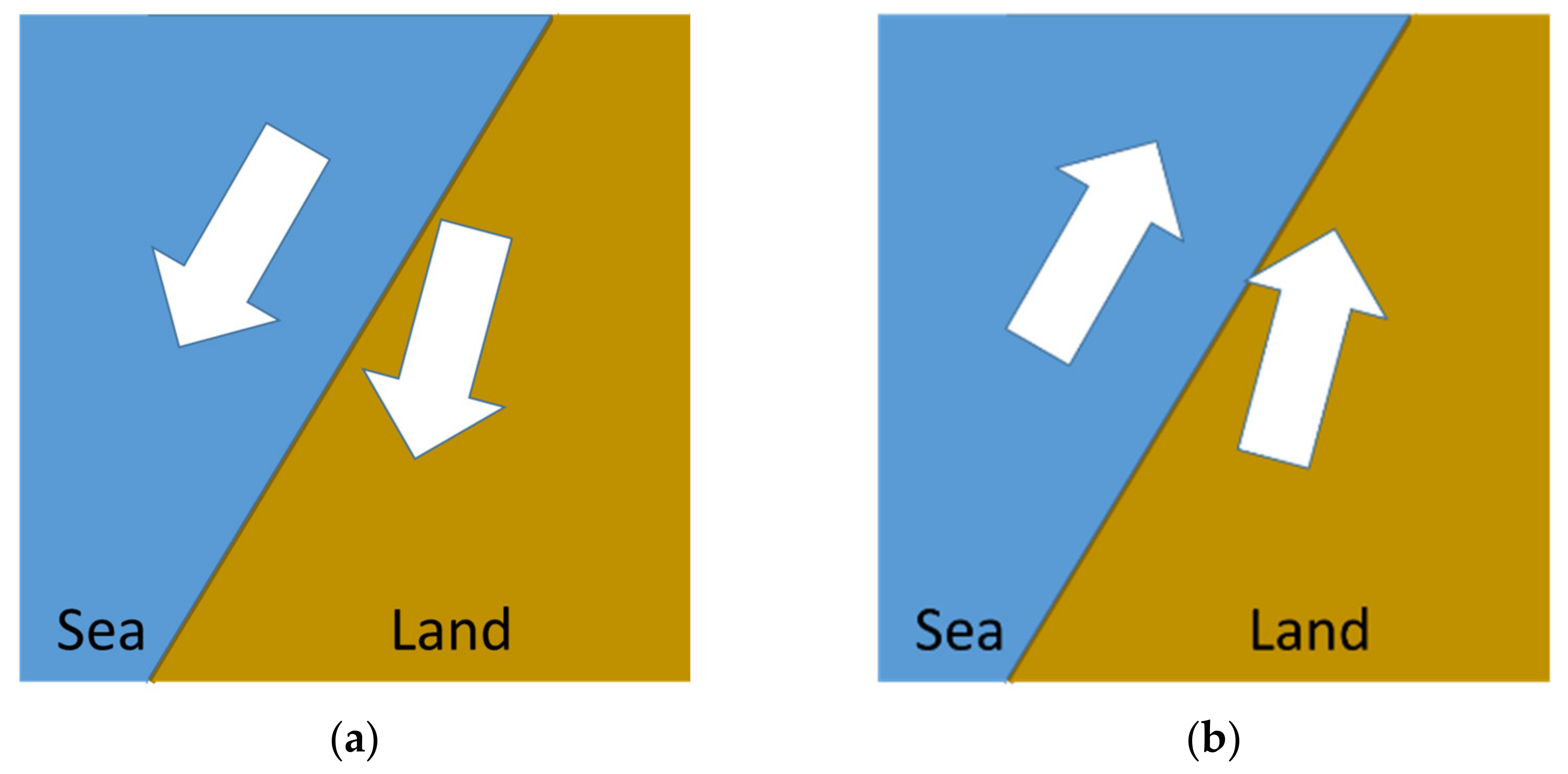
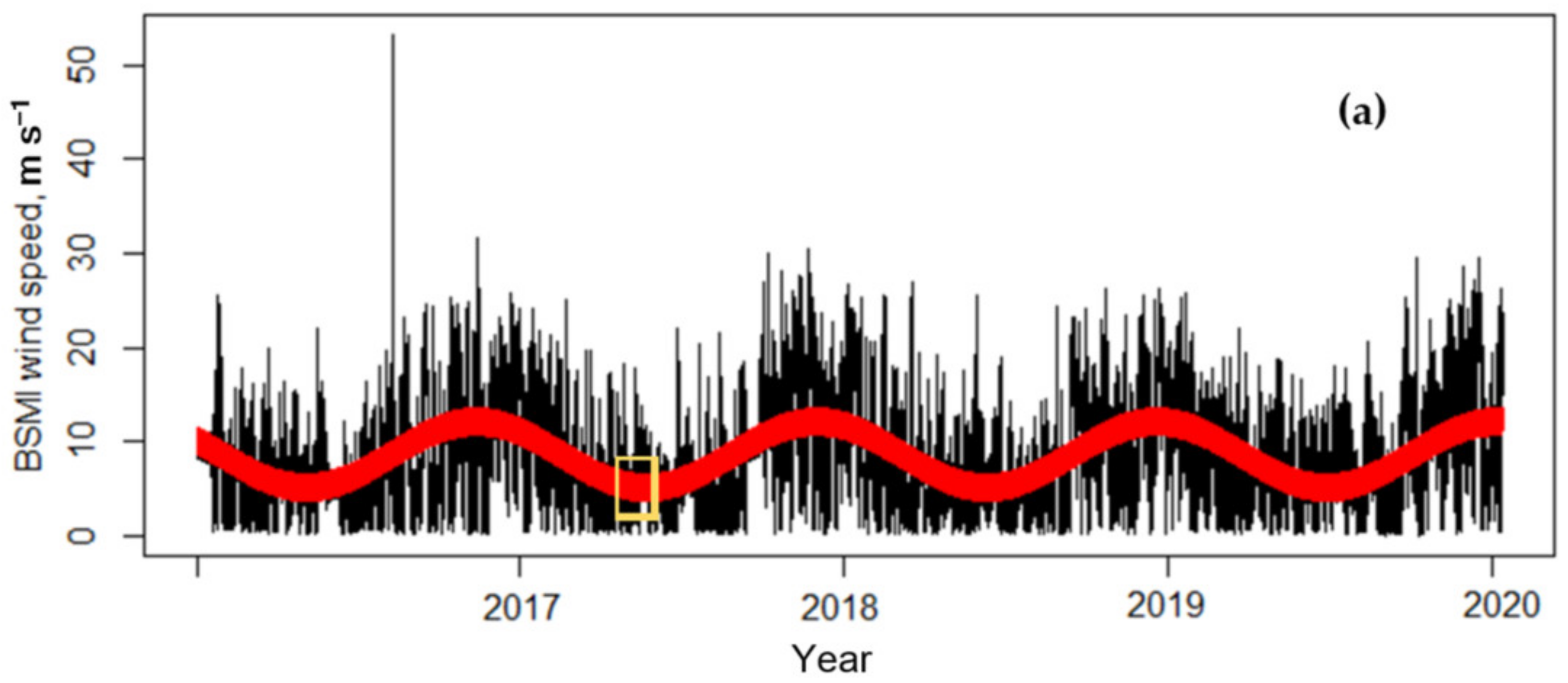
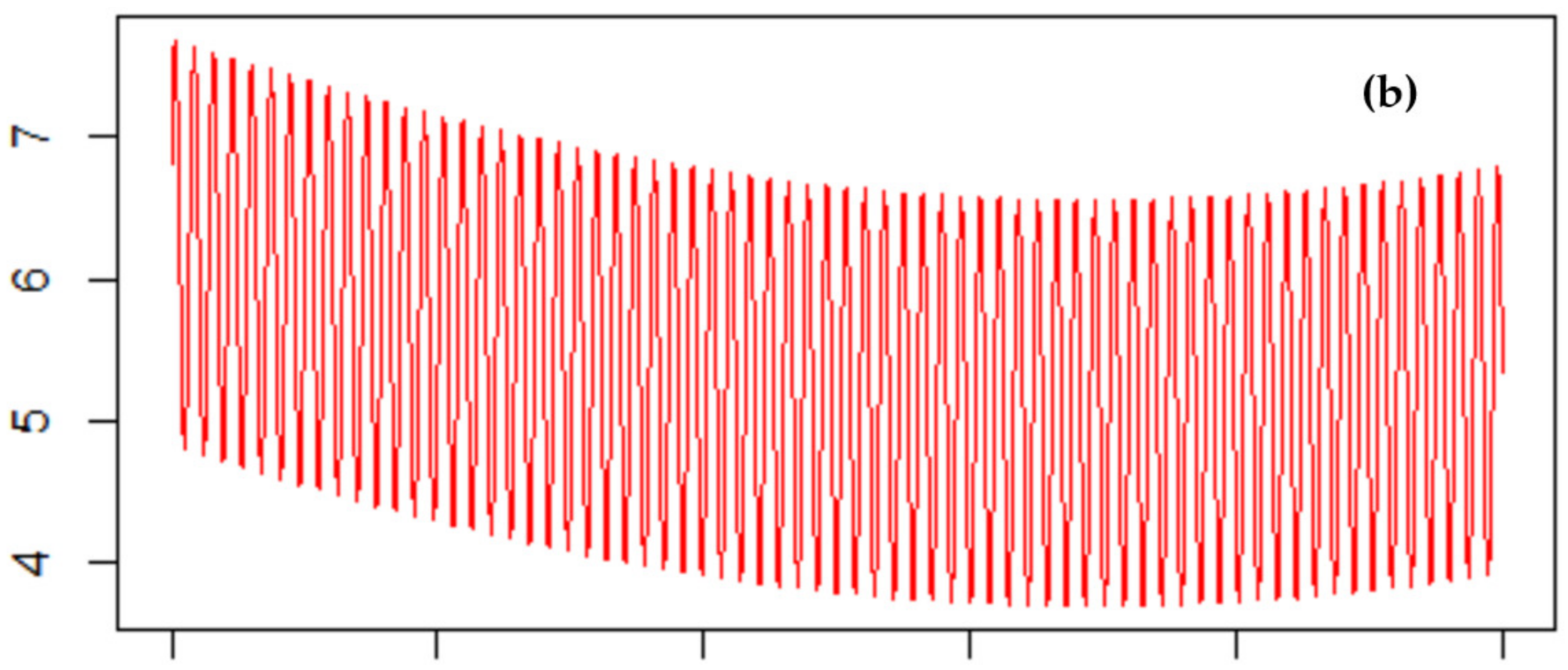
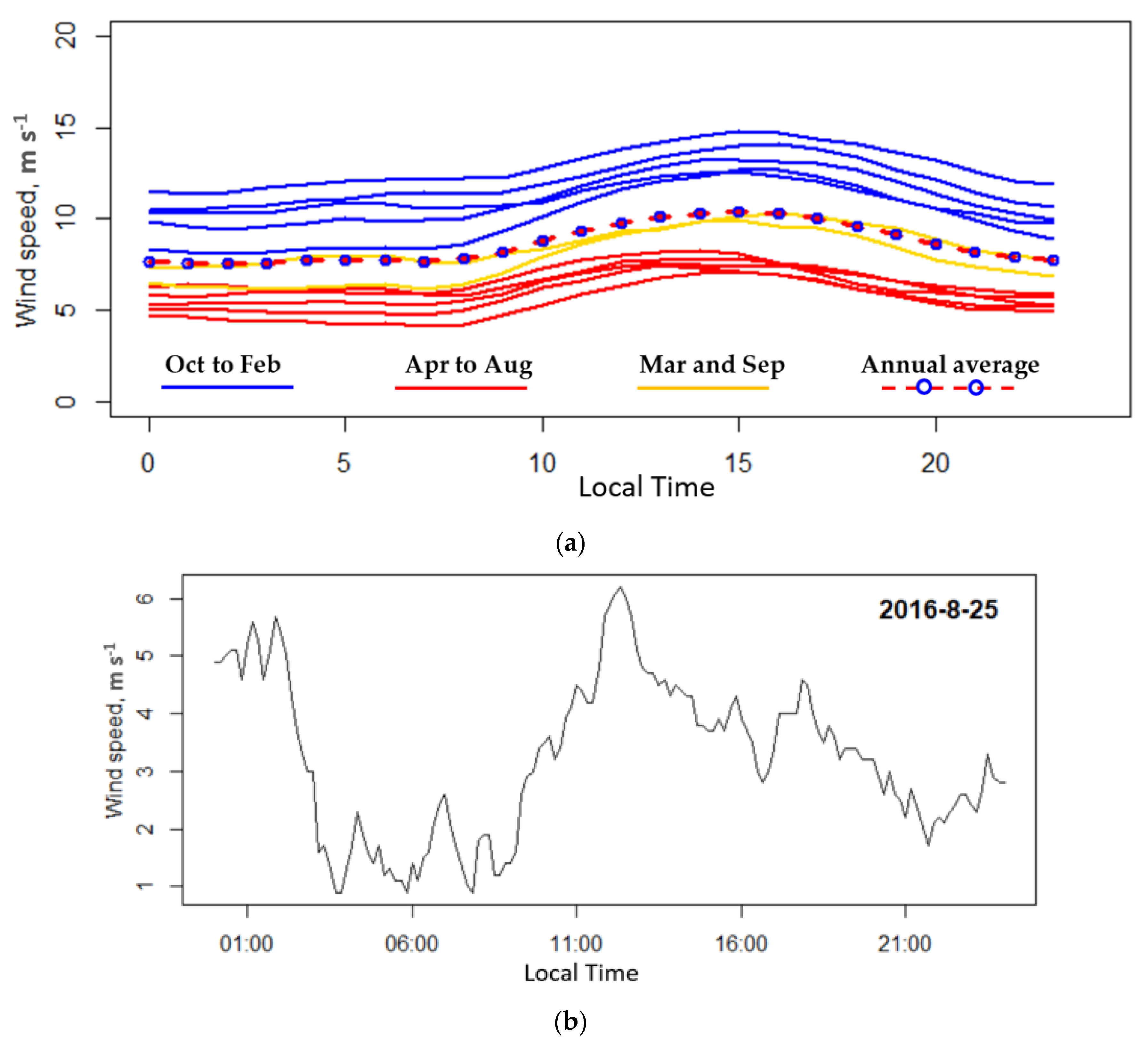
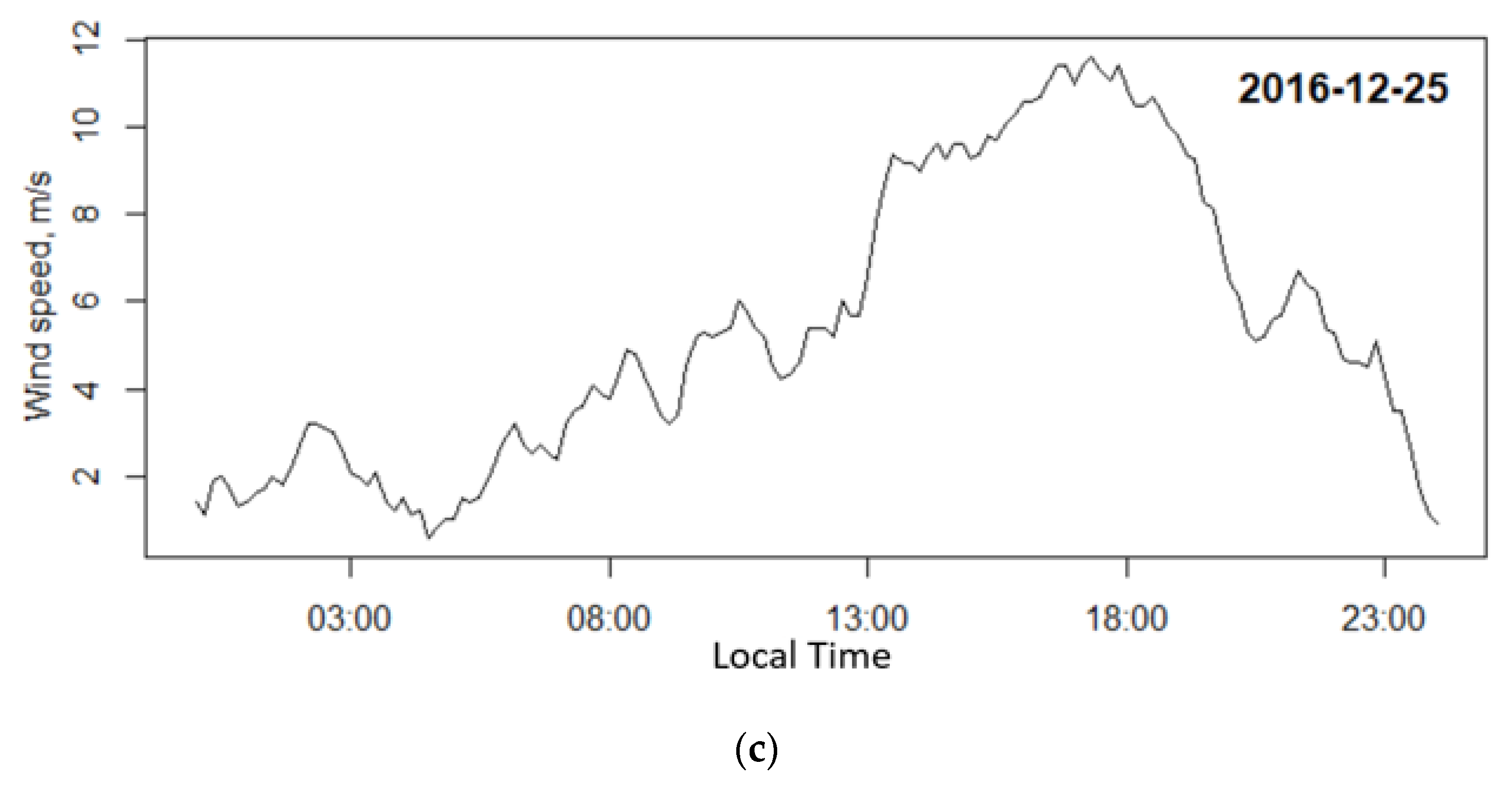
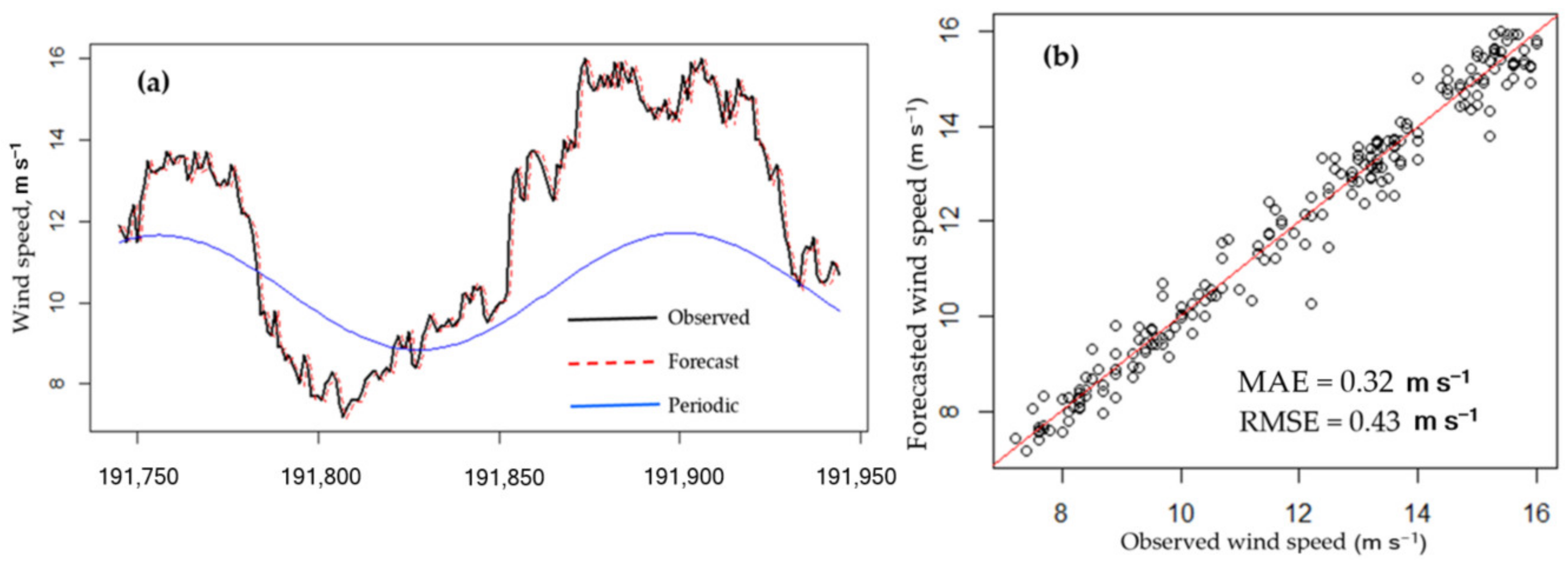

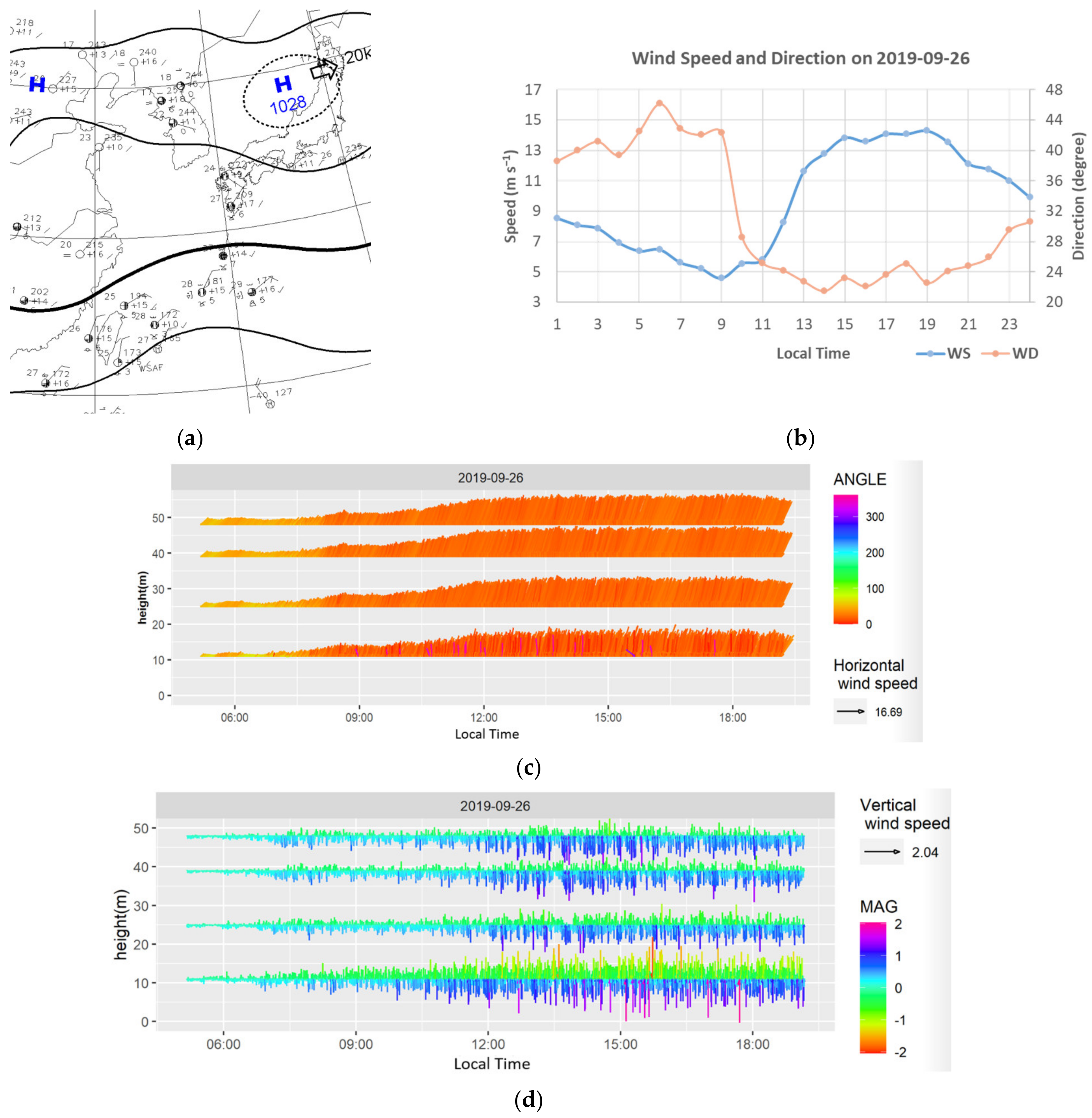
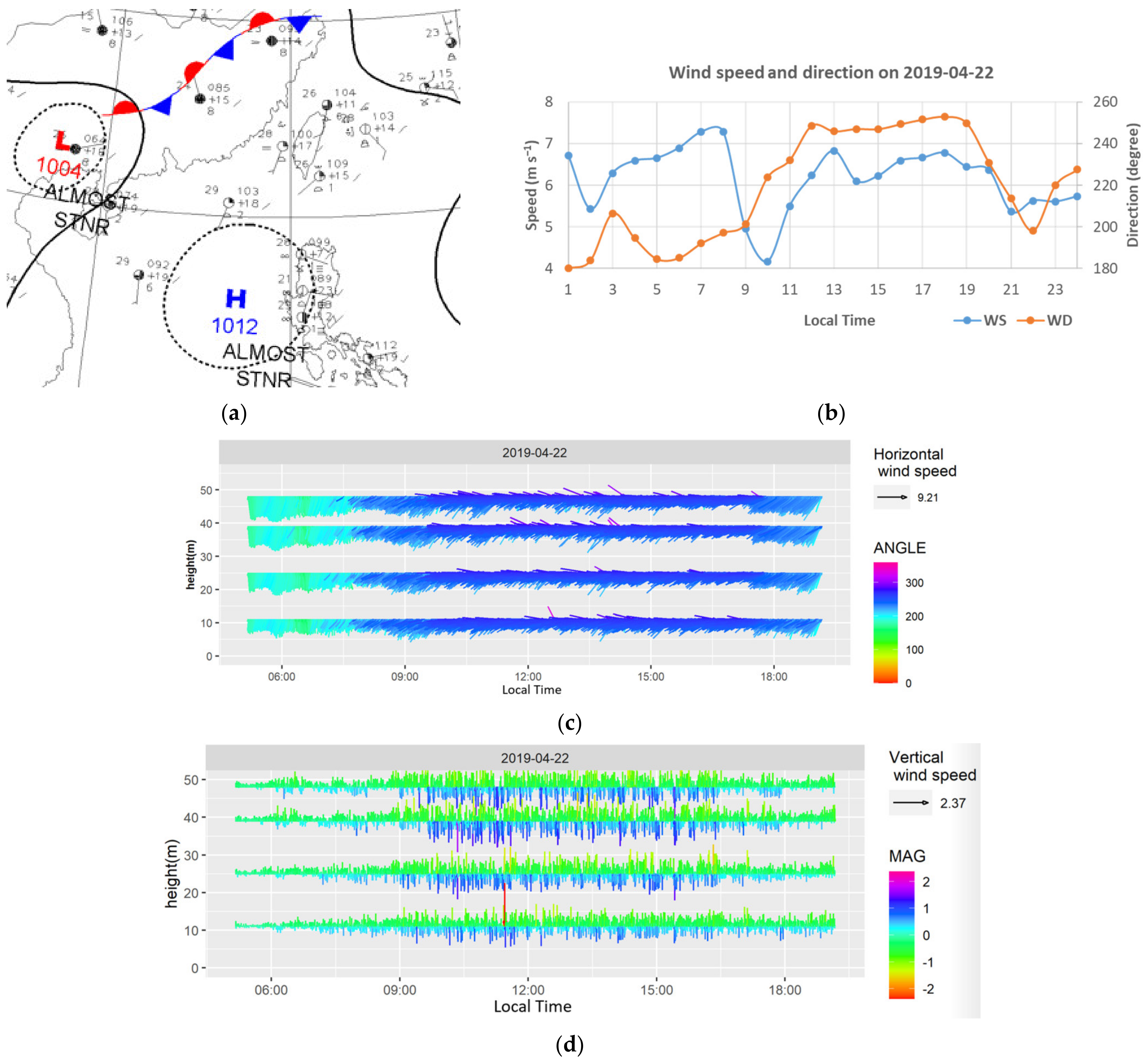

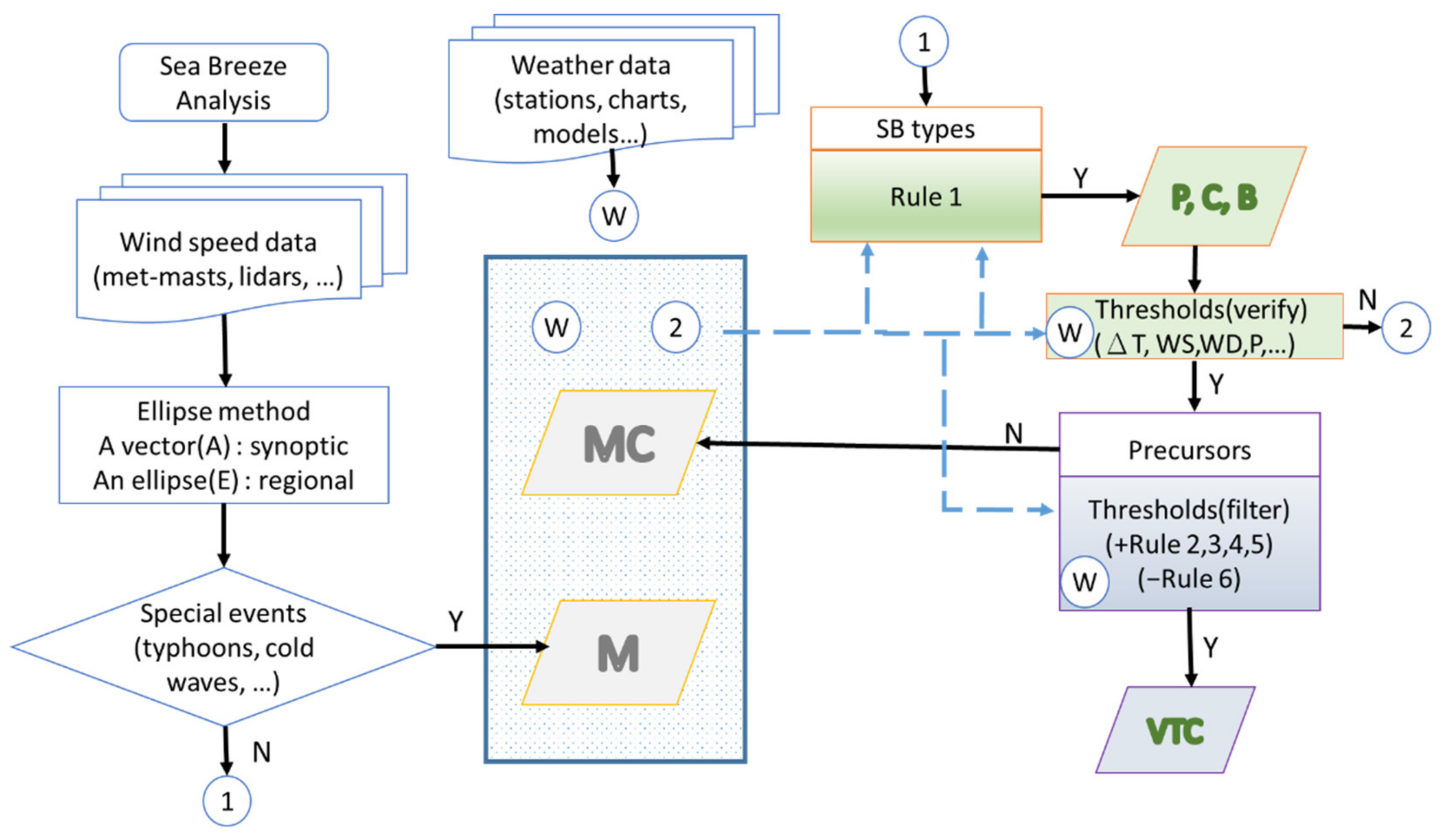

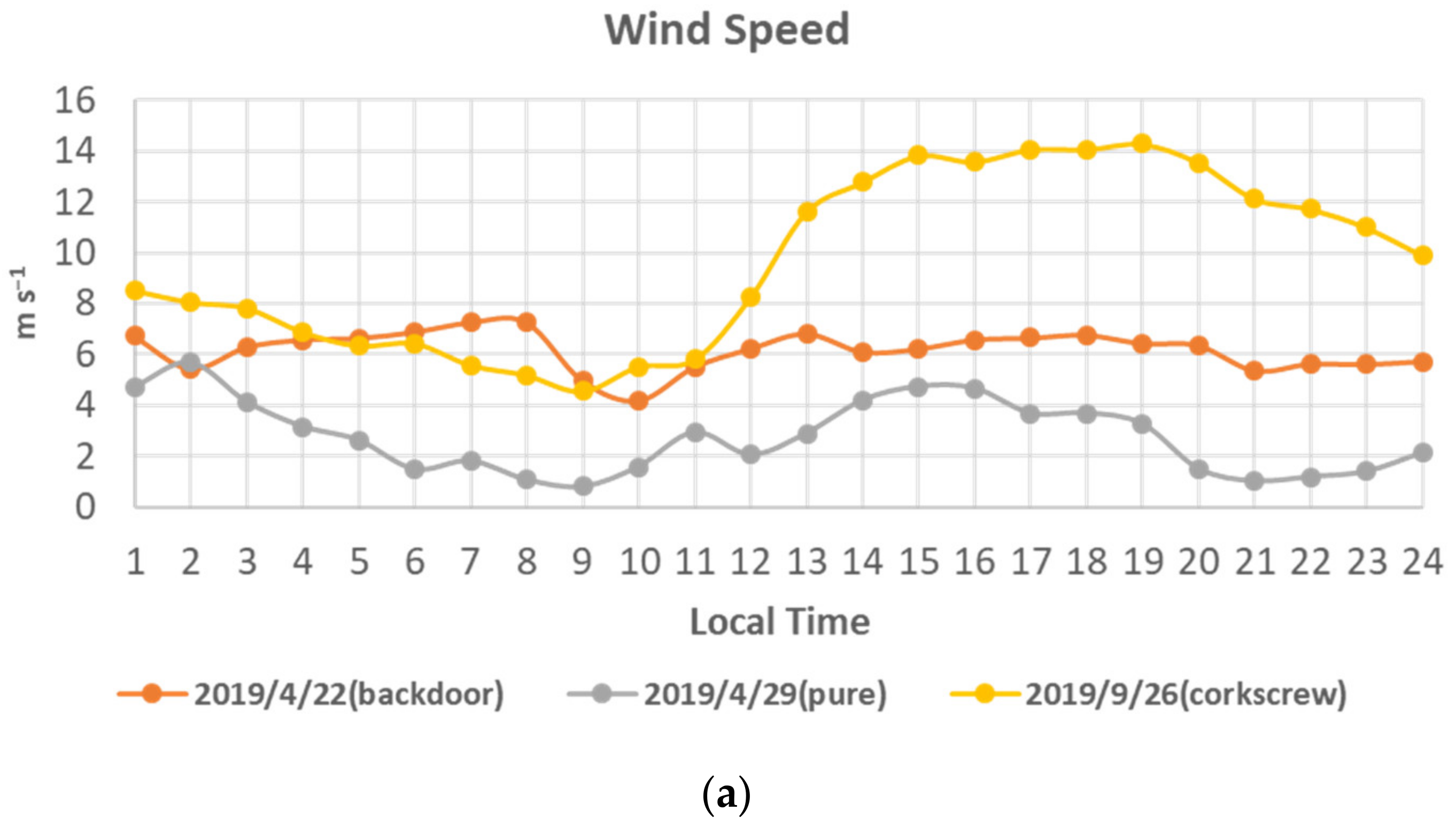
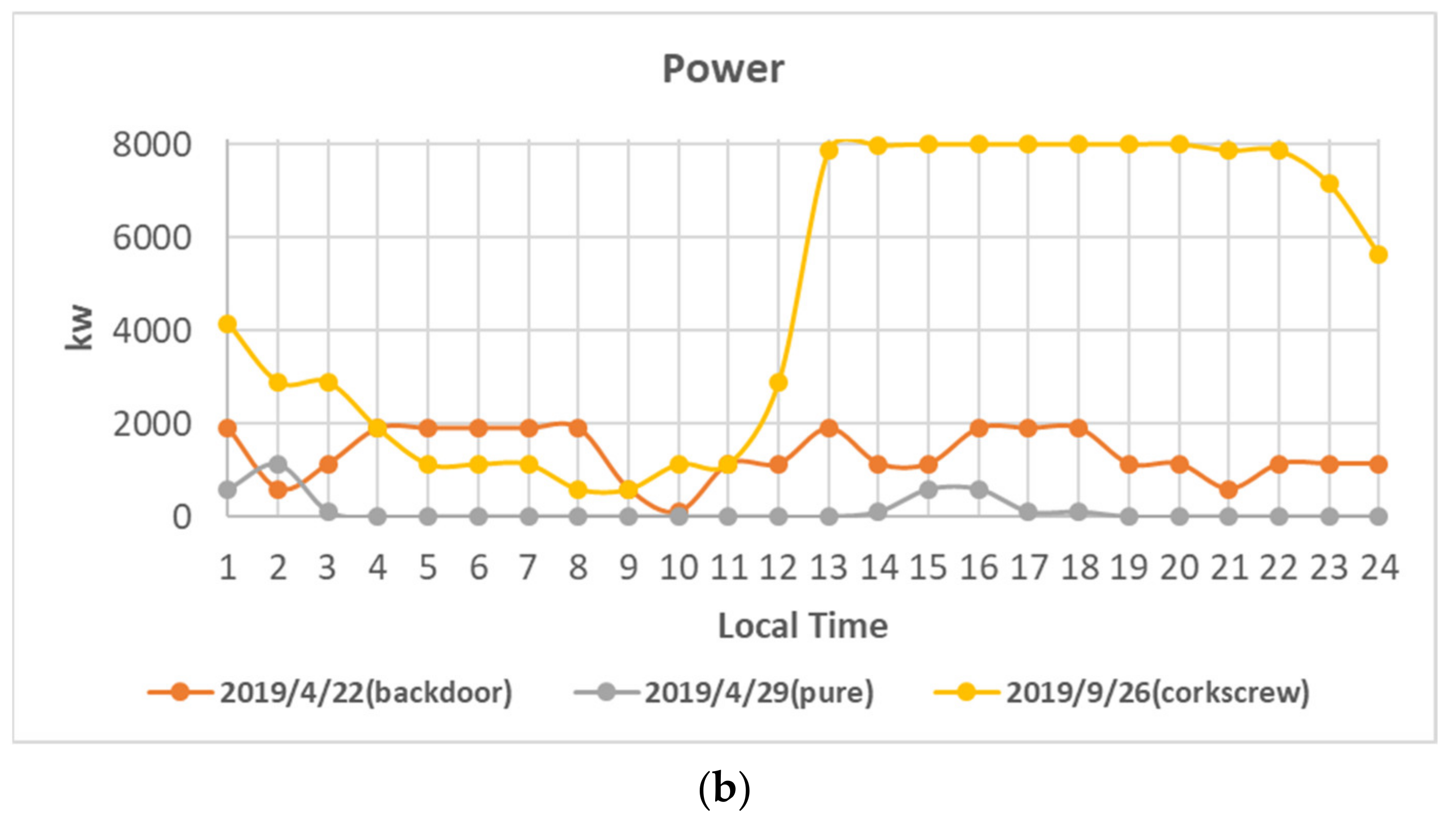
| Nonstationary component | |||||
| 8.62636 | 1.44623 | −3.04006 | −0.89615 | −1.04959 | |
| Stationary component AR(3) | |||||
| 1.00619 | −0.0887 | 0.0192 | 0.3464 |
| 4/11 [1b,4] | 4/21 [1c,4] | 9/14 [1b] | 9/24 [1b,4] | 10/4 [1b,2] | |
| 4/12 [1b,4] | 4/22 [1c] | 9/15 [1b,4] | 9/25 [1b,4] | 10/5 [1b,2,4] | |
| 4/3 [1b] | 4/13 [1b] | 4/23 [1c] | 9/16 [1b,4] | 9/26 [1b,4] | 10/6 [1b,4] |
| 4/4 [1b] | 4/14 [1b,4] | 4/24 [1c] | 9/17 [1b,4] | 9/27 [1b,4] | 10/7 [1b,4] |
| 4/5 [1b] | 4/15 [1b,4] | 4/25 [1c] | 9/18 [1b] | 9/28[1b,4] | 10/8 [1b,4] |
| 4/6 [1a] | 4/16 [1b] | 4/26 [1b,4] | 9/19 [1b] | 9/29 [1b,4] | 10/9 [1b,4] |
| 4/7 [1c] | 4/17 [1b,4] | 4/27 [1b,4] | 9/20 [1b] | 9/30 [1b,4] | 10/10 [1b] |
| 4/8 [1c] | 4/18 [1b,4] | 4/28 [1b] | 9/21 [1b,4] | 10/1 [1b] | 10/11 [1b] |
| 4/9 [1c] | 4/19 [1c,3] | 4/29 [1a] | 9/22 [1b,4] | 10/2 [1b] | 10/12 [1b,4] |
| 4/10 [1c,4] | 4/20 [1c,2] | 4/30 [1c] | 9/23 [1b,4] | 10/3 [1b,2] | 10/13 [1b,4] |
Publisher’s Note: MDPI stays neutral with regard to jurisdictional claims in published maps and institutional affiliations. |
© 2022 by the authors. Licensee MDPI, Basel, Switzerland. This article is an open access article distributed under the terms and conditions of the Creative Commons Attribution (CC BY) license (https://creativecommons.org/licenses/by/4.0/).
Share and Cite
Cheng, K.-S.; Ho, C.-Y.; Teng, J.-H. Wind and Sea Breeze Characteristics for the Offshore Wind Farms in the Central Coastal Area of Taiwan. Energies 2022, 15, 992. https://doi.org/10.3390/en15030992
Cheng K-S, Ho C-Y, Teng J-H. Wind and Sea Breeze Characteristics for the Offshore Wind Farms in the Central Coastal Area of Taiwan. Energies. 2022; 15(3):992. https://doi.org/10.3390/en15030992
Chicago/Turabian StyleCheng, Ke-Sheng, Cheng-Yu Ho, and Jen-Hsin Teng. 2022. "Wind and Sea Breeze Characteristics for the Offshore Wind Farms in the Central Coastal Area of Taiwan" Energies 15, no. 3: 992. https://doi.org/10.3390/en15030992
APA StyleCheng, K.-S., Ho, C.-Y., & Teng, J.-H. (2022). Wind and Sea Breeze Characteristics for the Offshore Wind Farms in the Central Coastal Area of Taiwan. Energies, 15(3), 992. https://doi.org/10.3390/en15030992






